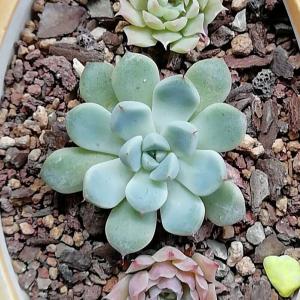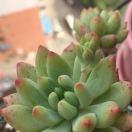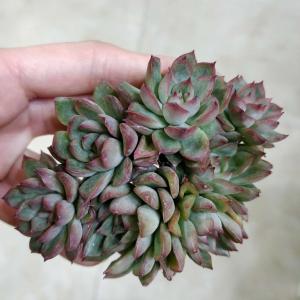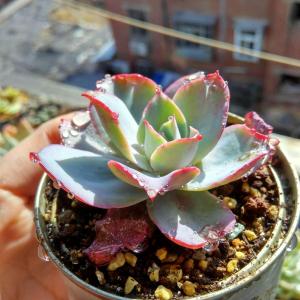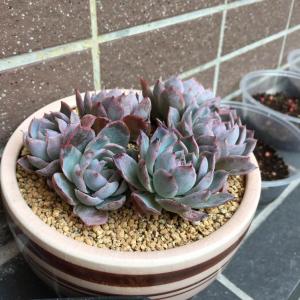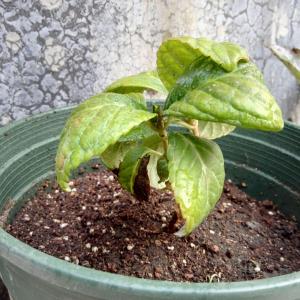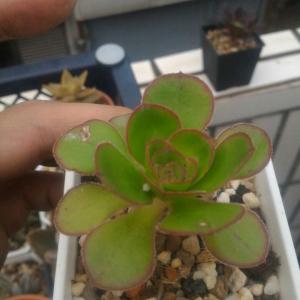文章
Miss Chen
2018年01月21日

Description: This is a herbaceous perennial plant that becomes ¾–2¼' tall at maturity, sending up one or more unbranched stems from the root system. The stems are light green to bluish green, terete, and glabrous; sometimes they have fine decurrent ridges that descend from the sessile leaves. The lowest leaves along these stems are usually opposite, otherwise they are all alternate; their blades are ascending to nearly erect. The leaf blades are up to 1" (2.5 cm) long and 3.5 mm. across; they are narrowly elliptic in shape with entire margins. Both the upper and lower surfaces of the leaf blades are light green to bluish green and glabrous. Only the central vein of each leaf is prominent. Each stem terminates in several elongated racemes of flowers that are erect to ascending. Each flower spans about 8 mm. (1/3") across, consisting of 5 yellow petals, 5 light green to bluish green sepals, 5 stamens, and a pistil. The petals are obovate and sometimes shallowly notched or wrinkled; the sepals are lanceolate and about one-half of the length of the petals. The inner sepals have stalked glands along their margins, while the outer sepals lack such glands. The pedicels of the flowers are up to 6 mm. (¼") long.

The blooming period occurs from mid-summer to early autumn, lasting about 1 month. Individual flowers are diurnal and short-lived. Afterwards, the flowers are replaced by small seed capsules about 2 mm. across; these capsules are subgloboid in shape and a little shorter than the sepals. At maturity, the capsules split open into 10 segments to release numerous tiny seeds. These seeds are small enough to be blown about by the wind. The root system consists of a small crown of shallow fibrous roots.
Cultivation: The preference is full sun, moist to mesic conditions, and soil containing calcareous sand, rocky material, or heavy clay-loam. This plant doesn't tolerated much competition from other ground vegetation, especially other broad-leaved plants (dicots). Depending on the local ecotype, the winter-hardiness and environmental preferences of this plant can vary significantly.
Stem & Alternate LeavesRange & Habitat: Stiff Yellow Flax is occasional along Lake Michigan in NE Illinois, uncommon in the southern half of Illinois, and rare or absent elsewhere within the state (see Distribution Map). It is native to Illinois and widely distributed in the eastern United States. Illinois lies along the NW range-limit of this species. Habitats include rocky upland woodlands, rocky glades, upland savannas, moist to dry sand prairies, borders of sandy ponds, moist sand flats (pannes) along Lake Michigan, borders of interdunal swales along Lake Michigan, and abandoned sand or gravel pits that have been excavated close to the surface of ground water. Stiff Yellow Flax is usually found in high quality natural areas.
Faunal Associations: Very little is known about the floral-faunal relationships of Stiff Yellow Flax (Linum medium texanum) and other native yellow-flowered flaxes (Linum spp.). The flowers of a closely related species (Linum sulcatum) were visited by bees and beetles (Smith et al., 2012; MacRae, 1991). The caterpillars of a polyphagous moth, Xestia c-nigrum (Lesser Black-letter Dart), use flax species as host plants (Wikipedia, 2015). During the winter, a small songbird, Ammodramus henslowii (Henslow's Sparrow), eats the seeds of Stiff Yellow Flax to a minor extent in Louisiana (DiMiceli, 2006). It is possible that other granivorous songbirds eat the seeds or seed capsules of this plant during autumn migration in Illinois.
Photographic Location: A moist sand flat (panne) near Lake Michigan in NE Illinois.
Comments: This is one of several yellow-flowered flax species (Linum spp.) that are native to Illinois and surrounding states. As a group, these species are not well-known and they are rarely cultivated. Their flowers are smaller in size and less showy than the often-cultivated Linum perenne lewisii (Wild Blue Flax). The typical variety of Stiff Yellow Flax, Linum medium medium, is found primarily in Ontario and it is quite rare. It differs from Linum medium texanum by its wider leaves (3.5–6 mm. across), and its seed capsules divide into 5 segments, rather than 10 segments. In regards to their chromosomes, Linum medium texanum is diploid, while Linum medium medium is tetraploid. The other species of yellow-flowered flax are very similar to Stiff Yellow Flax in appearance. One species, Linum sulcatum (Grooved Yellow Flax), is a herbaceous annual that has pairs of dark glands at the bases of its leaves, its leaves are more slender (linear-elliptic) in shape, and its stems sometimes branch underneath their inflorescences. Another species, Linum striatum (Ridged Yellow Flax), differs from Stiff Yellow Flax by having mostly opposite leaves, rather than alternate leaves. A third species, Linum virginianum (Woodland Yellow Flax), lacks stalked glands on its inner sepals, and the decurrent ridges along each stem that extend from its leaves are weaker and shorter.

The blooming period occurs from mid-summer to early autumn, lasting about 1 month. Individual flowers are diurnal and short-lived. Afterwards, the flowers are replaced by small seed capsules about 2 mm. across; these capsules are subgloboid in shape and a little shorter than the sepals. At maturity, the capsules split open into 10 segments to release numerous tiny seeds. These seeds are small enough to be blown about by the wind. The root system consists of a small crown of shallow fibrous roots.
Cultivation: The preference is full sun, moist to mesic conditions, and soil containing calcareous sand, rocky material, or heavy clay-loam. This plant doesn't tolerated much competition from other ground vegetation, especially other broad-leaved plants (dicots). Depending on the local ecotype, the winter-hardiness and environmental preferences of this plant can vary significantly.
Stem & Alternate LeavesRange & Habitat: Stiff Yellow Flax is occasional along Lake Michigan in NE Illinois, uncommon in the southern half of Illinois, and rare or absent elsewhere within the state (see Distribution Map). It is native to Illinois and widely distributed in the eastern United States. Illinois lies along the NW range-limit of this species. Habitats include rocky upland woodlands, rocky glades, upland savannas, moist to dry sand prairies, borders of sandy ponds, moist sand flats (pannes) along Lake Michigan, borders of interdunal swales along Lake Michigan, and abandoned sand or gravel pits that have been excavated close to the surface of ground water. Stiff Yellow Flax is usually found in high quality natural areas.
Faunal Associations: Very little is known about the floral-faunal relationships of Stiff Yellow Flax (Linum medium texanum) and other native yellow-flowered flaxes (Linum spp.). The flowers of a closely related species (Linum sulcatum) were visited by bees and beetles (Smith et al., 2012; MacRae, 1991). The caterpillars of a polyphagous moth, Xestia c-nigrum (Lesser Black-letter Dart), use flax species as host plants (Wikipedia, 2015). During the winter, a small songbird, Ammodramus henslowii (Henslow's Sparrow), eats the seeds of Stiff Yellow Flax to a minor extent in Louisiana (DiMiceli, 2006). It is possible that other granivorous songbirds eat the seeds or seed capsules of this plant during autumn migration in Illinois.
Photographic Location: A moist sand flat (panne) near Lake Michigan in NE Illinois.
Comments: This is one of several yellow-flowered flax species (Linum spp.) that are native to Illinois and surrounding states. As a group, these species are not well-known and they are rarely cultivated. Their flowers are smaller in size and less showy than the often-cultivated Linum perenne lewisii (Wild Blue Flax). The typical variety of Stiff Yellow Flax, Linum medium medium, is found primarily in Ontario and it is quite rare. It differs from Linum medium texanum by its wider leaves (3.5–6 mm. across), and its seed capsules divide into 5 segments, rather than 10 segments. In regards to their chromosomes, Linum medium texanum is diploid, while Linum medium medium is tetraploid. The other species of yellow-flowered flax are very similar to Stiff Yellow Flax in appearance. One species, Linum sulcatum (Grooved Yellow Flax), is a herbaceous annual that has pairs of dark glands at the bases of its leaves, its leaves are more slender (linear-elliptic) in shape, and its stems sometimes branch underneath their inflorescences. Another species, Linum striatum (Ridged Yellow Flax), differs from Stiff Yellow Flax by having mostly opposite leaves, rather than alternate leaves. A third species, Linum virginianum (Woodland Yellow Flax), lacks stalked glands on its inner sepals, and the decurrent ridges along each stem that extend from its leaves are weaker and shorter.
0
0
文章
Miss Chen
2018年01月21日

Description: This perennial herbaceous plant is ¾–2½' tall and unbranched. The erect central stem is variably colored (light green, light reddish green, or light whitish yellow), terete, glabrous, and often glaucous. Along the entire length of this stem, except at the apex, there are numerous alternate leaves with strongly ascending blades. The sessile leaf blades are 1½–3" long, less than ½" across, linear-elliptic in shape, and entire along their margins; their lower/outer surface is olive green and glabrous, while their upper/inner surface is medium green and glabrous. Each leaf blade has several conspicuous parallel veins. At the apex of the stem, there is typically a single whorl of 3-6 leaves. The blades of these whorled leaves are simlar in size and shape to the alternate leaves; they are ascending. Some plants may have more than one whorl of leaves, but this is unusual. The central stem terminates in 1-3 (rarely 4-5) flowers on stout pedicels. The erect to ascending pedicels are 2-6" long, medium green, terete, glabrous, and sometimes glaucous. Individual flowers are 2-3" long and similarly across.
Each flower consists of 6 orange to reddish tepals, 6 stamens with orange to reddish filaments, an orange to reddish style with a swollen stigma, and a green ovary. The ascending tepals are narrowly clawed below and lanceolate to ovate above; they are slightly incurved below and slightly recurved above. A little above their clawed bases, the tepals are more yellowish and they have conspicuous purplish brown dots. Both stamens and style are slightly exserted; the stamens surround the style in the center of the flower. The blooming period occurs from early to mid-summer, lasting about 3-5 weeks. Afterwards, fertile flowers are replaced by oblongoid seed capsules that are 1½–2¾" long. Each seed capsule has 3 cells, and each cell has 2 columns of flattened seeds. The root system consists of a scaly corm that occasionally forms clonal offsets; the bottom of the corm develops shallow fibrous roots.
Cultivation: The preference is full or partial sun, moist to mesic conditions, and soil containing loam or sandy loam. This plant develops slowly.

Range & Habitat: The native Prairie Lily is uncommon in northern Illinois, while in the rest of the state it is rare or absent (see Distribution Map). Populations of this plant have been declining, or they have been extirpated, in some areas. Habitats include thinly wooded bluffs, moist to mesic black soil prairies, moist to mesic sand prairies, grassy meadows, and powerline clearances through natural areas. Prairie Lily is normally found in high quality natural areas. Occasional disturbance that involves removal of woody vegetation is probably beneficial in maintaining populations of this plant. Because of the showy flowers, it is vulnerable to poaching, like many orchids.
Faunal Associations: The flowers are cross-pollinated primarily by large butterflies, including swallowtail butterflies (Papilionidae), the Monarch butterfly (Danaus plexippus), and Great Spangled Fritillary (Speyeria cybele). Other floral visitors include the Ruby-throated Hummingbird, hummingbird moths (Hemaris spp.), and Halictid bees. Most of these floral visitors suck nectar from the flowers, although the Halictid bees collect pollen (see Graenicher, 1907; Edwards & Jordan, 1992). Other insects feed destructively on Prairie Lily (Lilium philadelphicum andinum) and other closely related lilies (Lilium spp.). These insects include the introduced Lily Leaf Beetle (Lilioceris lilii), Crescent-marked Lily Aphid (Aulacorthum circumflexum), Purple-spotted Lily Aphid (Macrosiphum lilii), and larvae of the Golden Borer Moth (Papaipema cerina), Burdock Borer Moth (Papaipema cataphracta), and Stalk Borer Moth (Papaipema nebris); see Clark et al. (2004), Cranshaw (2006), Pepper (1965), Panzer et al. (2006), and Natural History Museum (2010). The larvae of these latter moths bore through the stems and corms of lilies. Mammalian herbivores readily consume the foliage of Prairie Lily and other closely related lilies, especially the White-tailed Deer. The corms are also eaten sometimes by voles.

Photographic Location: A powerline clearance and moist sandy meadows at a state park in NE Illinois.
Comments: The flowers of this plant can be remarkably large, considering its size. This is arguably one of the most beautiful wildflowers in Illinois. Other native lilies (Lilium spp.) in Illinois are taller plants with whorled leaves and drooping flowers; only the flowers of Prairie Lily (Lilium philadelphicum andinum) remain erect. One reason why this plant has erect flowers is that the anthers can close their pores temporarily in response to rain, thereby protecting the pollen (Edwards & Jordan, 1992). This is a highly unusual characteristic. The typical variety of this plant is the more eastern Wood Lily (Lilium philadelphicum philadelphicum), which is not found in Illinois. The Wood Lily differs from the Prairie Lily in being a slightly taller plant that has mostly whorled leaves, its leaves are usually wider (often exceeding ½" across), and its seed capsules are slightly shorter. In the past, the Prairie Lily was sometimes classified as a distinct species, or Lilium umbellatum. Other common names for this plant are Western Lily and Wood Lily. Outside of Illinois, there are yellow-flowered forms of this species.
Each flower consists of 6 orange to reddish tepals, 6 stamens with orange to reddish filaments, an orange to reddish style with a swollen stigma, and a green ovary. The ascending tepals are narrowly clawed below and lanceolate to ovate above; they are slightly incurved below and slightly recurved above. A little above their clawed bases, the tepals are more yellowish and they have conspicuous purplish brown dots. Both stamens and style are slightly exserted; the stamens surround the style in the center of the flower. The blooming period occurs from early to mid-summer, lasting about 3-5 weeks. Afterwards, fertile flowers are replaced by oblongoid seed capsules that are 1½–2¾" long. Each seed capsule has 3 cells, and each cell has 2 columns of flattened seeds. The root system consists of a scaly corm that occasionally forms clonal offsets; the bottom of the corm develops shallow fibrous roots.
Cultivation: The preference is full or partial sun, moist to mesic conditions, and soil containing loam or sandy loam. This plant develops slowly.

Range & Habitat: The native Prairie Lily is uncommon in northern Illinois, while in the rest of the state it is rare or absent (see Distribution Map). Populations of this plant have been declining, or they have been extirpated, in some areas. Habitats include thinly wooded bluffs, moist to mesic black soil prairies, moist to mesic sand prairies, grassy meadows, and powerline clearances through natural areas. Prairie Lily is normally found in high quality natural areas. Occasional disturbance that involves removal of woody vegetation is probably beneficial in maintaining populations of this plant. Because of the showy flowers, it is vulnerable to poaching, like many orchids.
Faunal Associations: The flowers are cross-pollinated primarily by large butterflies, including swallowtail butterflies (Papilionidae), the Monarch butterfly (Danaus plexippus), and Great Spangled Fritillary (Speyeria cybele). Other floral visitors include the Ruby-throated Hummingbird, hummingbird moths (Hemaris spp.), and Halictid bees. Most of these floral visitors suck nectar from the flowers, although the Halictid bees collect pollen (see Graenicher, 1907; Edwards & Jordan, 1992). Other insects feed destructively on Prairie Lily (Lilium philadelphicum andinum) and other closely related lilies (Lilium spp.). These insects include the introduced Lily Leaf Beetle (Lilioceris lilii), Crescent-marked Lily Aphid (Aulacorthum circumflexum), Purple-spotted Lily Aphid (Macrosiphum lilii), and larvae of the Golden Borer Moth (Papaipema cerina), Burdock Borer Moth (Papaipema cataphracta), and Stalk Borer Moth (Papaipema nebris); see Clark et al. (2004), Cranshaw (2006), Pepper (1965), Panzer et al. (2006), and Natural History Museum (2010). The larvae of these latter moths bore through the stems and corms of lilies. Mammalian herbivores readily consume the foliage of Prairie Lily and other closely related lilies, especially the White-tailed Deer. The corms are also eaten sometimes by voles.

Photographic Location: A powerline clearance and moist sandy meadows at a state park in NE Illinois.
Comments: The flowers of this plant can be remarkably large, considering its size. This is arguably one of the most beautiful wildflowers in Illinois. Other native lilies (Lilium spp.) in Illinois are taller plants with whorled leaves and drooping flowers; only the flowers of Prairie Lily (Lilium philadelphicum andinum) remain erect. One reason why this plant has erect flowers is that the anthers can close their pores temporarily in response to rain, thereby protecting the pollen (Edwards & Jordan, 1992). This is a highly unusual characteristic. The typical variety of this plant is the more eastern Wood Lily (Lilium philadelphicum philadelphicum), which is not found in Illinois. The Wood Lily differs from the Prairie Lily in being a slightly taller plant that has mostly whorled leaves, its leaves are usually wider (often exceeding ½" across), and its seed capsules are slightly shorter. In the past, the Prairie Lily was sometimes classified as a distinct species, or Lilium umbellatum. Other common names for this plant are Western Lily and Wood Lily. Outside of Illinois, there are yellow-flowered forms of this species.
0
0
文章
Miss Chen
2018年01月19日

Description: This perennial wildflower is 1–2½' tall and unbranched. The central stem is light green, slightly ridged, and glabrous to hairy. The alternate leaves occur along the entire length of the stem in widely spreading pseudo-whorls. The lowest leaves are 4-6" long and about ¼" across, becoming gradually smaller as they ascend the stem. The leaves are medium green, linear in shape, sessile, and glabrous to short-pubescent. Each stem terminates in a spike or narrow raceme of flowerheads about 2-8" long. These flowerheads are relatively few in number, and on rare occasions only a single flowerhead may be produced. Each flat-topped flowerhead is about ½–1" across, consisting of 15-45 pink disk florets above and overlapping floral bracts (phyllaries) below. There are no ray florets. Individual disk florets are tubular in shape; each of these florets has 5 recurved slender lobes at its apex. Each disk floret has a bifurcated style that is white to light pink; it is often strongly exerted and recurved.

The scaly bracts are green, glabrous to hairy, and relatively large in size; they are either straight and loosely arranged around the base of each flowerhead, or they are strongly recurved. The bracts are lanceolate, broadly lanceolate, or deltoid in shape and their tips are pointed, rather than rounded. The flowerheads are either sessile (or nearly so), or they can have peduncles up to 1¼" long. At the base of each peduncle (or sessile flowerhead), there is a small leafy bract that is linear in shape. The blooming period occurs from mid- to late summer and lasts about 1 month. The flowerheads bloom from the top to the bottom. With maturation, the disk florets are replaced by small achenes that are bullet-shaped and pubescent; each achene has a tuft of feathery bristles at its apex. The achenes are distributed by the wind to some extent. The root system consists of a globoid corm with fibrous roots below. Sometimes vegetative offsets are produced.
Cultivation: The preference is full sun, dry-mesic to dry conditions, and a barren soil containing rocky material or some sand.
Central Stem & Leaves
Range & Habitat: The native Scaly Blazingstar is occasional in southern Illinois and absent elsewhere in the state (see Distribution Map). Habitats include hill prairies, limestone or sandstone glades, ledges of sunny cliffs, openings in upland rocky woodlands, and barren savannas. This wildflower is found in high quality natural areas. Occasional wildfires are beneficial because the encroachment of woody vegetation is reduced.
Faunal Assocations: The flowerheads are cross-pollinated primarily by bumblebees, butterflies, and skippers. In general, several insect species feed on Liatris spp. (Blazingstars). These species include: the caterpillars of Schinia sanguinea (Blazingstar Flower Moth), which feed on the florets and developing seeds; the caterpillars of Papaipema beeriana (Blazingstar Borer Moth) and Carmenta anthracipennis (Liatris Borer Moth), which bore through the stems; and the aphids Aphis laciniariae and Aphis craccivora, which suck plant juices. The foliage and flowerheads of Blazingstars are edible to many mammalian herbivores, including cattle, horses, sheep, goats, deer, rabbits, and groundhogs. Where these mammals are abundant, Blazingstar populations usually decline.
Photographic Location: The wildflower garden of the webmaster in Urbana, Illinois.
Comments: Scaly Blazingstar is highly variable across its range and several varieties have been described. Generally, all of these varieties have relatively large floral bracts with pointed tips that are either loosely arranged or recurved along the bottoms of the flowerheads. However, there is considerable variability in the following characteristics: 1) the size of individual flowerheads can be variable with 15-45 (or more) disk florets, 2) the flowerheads can be sessile or they can have short to medium-length peduncles, 3) the leaves and stems can be glabrous to hairy, and 4) the floral bracts that define the base of each flowerhead can be either straight or strongly recurved. Scaly Blazingstar differs from other Liatris spp. (Blazingstars) primarily by the characteristics of its scaly floral bracts, which provide it with a rather odd appearance.

The scaly bracts are green, glabrous to hairy, and relatively large in size; they are either straight and loosely arranged around the base of each flowerhead, or they are strongly recurved. The bracts are lanceolate, broadly lanceolate, or deltoid in shape and their tips are pointed, rather than rounded. The flowerheads are either sessile (or nearly so), or they can have peduncles up to 1¼" long. At the base of each peduncle (or sessile flowerhead), there is a small leafy bract that is linear in shape. The blooming period occurs from mid- to late summer and lasts about 1 month. The flowerheads bloom from the top to the bottom. With maturation, the disk florets are replaced by small achenes that are bullet-shaped and pubescent; each achene has a tuft of feathery bristles at its apex. The achenes are distributed by the wind to some extent. The root system consists of a globoid corm with fibrous roots below. Sometimes vegetative offsets are produced.
Cultivation: The preference is full sun, dry-mesic to dry conditions, and a barren soil containing rocky material or some sand.
Central Stem & Leaves
Range & Habitat: The native Scaly Blazingstar is occasional in southern Illinois and absent elsewhere in the state (see Distribution Map). Habitats include hill prairies, limestone or sandstone glades, ledges of sunny cliffs, openings in upland rocky woodlands, and barren savannas. This wildflower is found in high quality natural areas. Occasional wildfires are beneficial because the encroachment of woody vegetation is reduced.
Faunal Assocations: The flowerheads are cross-pollinated primarily by bumblebees, butterflies, and skippers. In general, several insect species feed on Liatris spp. (Blazingstars). These species include: the caterpillars of Schinia sanguinea (Blazingstar Flower Moth), which feed on the florets and developing seeds; the caterpillars of Papaipema beeriana (Blazingstar Borer Moth) and Carmenta anthracipennis (Liatris Borer Moth), which bore through the stems; and the aphids Aphis laciniariae and Aphis craccivora, which suck plant juices. The foliage and flowerheads of Blazingstars are edible to many mammalian herbivores, including cattle, horses, sheep, goats, deer, rabbits, and groundhogs. Where these mammals are abundant, Blazingstar populations usually decline.
Photographic Location: The wildflower garden of the webmaster in Urbana, Illinois.
Comments: Scaly Blazingstar is highly variable across its range and several varieties have been described. Generally, all of these varieties have relatively large floral bracts with pointed tips that are either loosely arranged or recurved along the bottoms of the flowerheads. However, there is considerable variability in the following characteristics: 1) the size of individual flowerheads can be variable with 15-45 (or more) disk florets, 2) the flowerheads can be sessile or they can have short to medium-length peduncles, 3) the leaves and stems can be glabrous to hairy, and 4) the floral bracts that define the base of each flowerhead can be either straight or strongly recurved. Scaly Blazingstar differs from other Liatris spp. (Blazingstars) primarily by the characteristics of its scaly floral bracts, which provide it with a rather odd appearance.
0
0
文章
Miss Chen
2018年01月19日

Description: This perennial plant is 2-5' and unbranched. The central stem is green or dark red, and it has short stiff hairs. The leaves toward the base are up to 12" long and 1" wide, becoming progessively shorter and narrower as they alternate up the stalk. The leaves are sufficiently crowded together that they appear whorled. They are narrowly lanceolate or linear, dull green or bluish green, and usually slightly pubescent. The margins are smooth or slightly ciliate.
The central stem terminates in an erect spike-like inflorescence with pink or purplish pink composite flowers. This inflorescence is about ½–1½' long, with the composite flowers more or less densely distributed along its length. The individual flowers are crowded together into buttons about 1" across. Each flower has 5 lobes that spread outward from the corolla tube, from which emerges a long divided style that is often curly. There is no floral scent. The blooming period occurs from late summer to early fall and lasts about 3 weeks for individual plants. Like other Liatris spp., the flowers of Rough Blazingstar begin to bloom at the top of the flowering stalk, and gradually bloom downward as the season progresses. The achenes have large tufts of stiff hair that are light greyish brown, which enables them to be distributed several feet by the wind. The root system consists of a woody corm. Occasionally, offsets develop a short distance from the mother plant, creating small colonies.

Cultivation: The preference is full sun and mesic to dry conditions. The soil can contain significant amounts of loam, clay, sand, or rocky material. However, this plant typically grows in less fertile acidic soil that is rather rocky or sandy. This plant is easy to grow under well-drained conditions, but has a tendency to flop over while in flower if it is spoiled with rich soil or too much moisture. Foliar disease is rarely a problem, and drought resistant is very good, with only a few lower leaves withering away.
Range & Habitat: The native Rough Blazingstar is occasional in central and northern Illinois, but it is uncommon or absent in SE Illinois (see Distribution Map). This wildflower is widely distributed, but rarely forms large colonies in native habitats, unlike Liatris pychnostachya (Prairie Blazingstar). Habitats include mesic to dry black soil prairies, sand prairies, gravel prairies, hill prairies, bald knobs, openings in rocky upland forests, sandy Black Oak woodlands, savannas, limestone glades, dry clay banks above ditches, and open areas along railroads, particularly where prairie remnants occur.

Faunal Associations: Primarily long-tongued bees, butterflies, skippers, and bee flies visit the flowers. Among the long-tongued bees, this includes honeybees, bumblebees, Little Carpenter bees, Miner bees, and Leaf-Cutting bees. Butterfly visitors include Monarchs, Painted Ladies, Black Swallowtails, Sulfurs, and others. Other visitors include Green Metallic bees and other Halictine bees. The latter bees collect pollen primarily, and are not effective pollinators. The caterpillars of the rare Schinia florida (Glorious Flower Moth) feed on the flowers and seed capsules of this and other Liatris spp. Mammmalian herbivores, large and small, readily eat the foliage and stems, including rabbits, deer, groundhogs, and livestock. Sometimes small rodents will dig up the corms and eat them. Consequently, this plant may be scarce where there is an overpopulation of these animals.

Photographic Location: The photographs were taken at Red Bison Railroad Prairie in Savoy, Illinois, Meadowbrook Park in Urbana, Illinois, and the wildflower garden of the webmaster.
Comments: This is a beautiful plant while it is flowering, although the blooming period is rather short. It is possible to extend the season of bloom by planting other Liatris spp, which usually bloom earlier in the year. Among the taller blazingstars, this species prefers drier locations, and can be distinguished from them by the large size of its buttons of flowers. The corms were used as an emergency survival food among some tribes of Amerindians.
The central stem terminates in an erect spike-like inflorescence with pink or purplish pink composite flowers. This inflorescence is about ½–1½' long, with the composite flowers more or less densely distributed along its length. The individual flowers are crowded together into buttons about 1" across. Each flower has 5 lobes that spread outward from the corolla tube, from which emerges a long divided style that is often curly. There is no floral scent. The blooming period occurs from late summer to early fall and lasts about 3 weeks for individual plants. Like other Liatris spp., the flowers of Rough Blazingstar begin to bloom at the top of the flowering stalk, and gradually bloom downward as the season progresses. The achenes have large tufts of stiff hair that are light greyish brown, which enables them to be distributed several feet by the wind. The root system consists of a woody corm. Occasionally, offsets develop a short distance from the mother plant, creating small colonies.

Cultivation: The preference is full sun and mesic to dry conditions. The soil can contain significant amounts of loam, clay, sand, or rocky material. However, this plant typically grows in less fertile acidic soil that is rather rocky or sandy. This plant is easy to grow under well-drained conditions, but has a tendency to flop over while in flower if it is spoiled with rich soil or too much moisture. Foliar disease is rarely a problem, and drought resistant is very good, with only a few lower leaves withering away.
Range & Habitat: The native Rough Blazingstar is occasional in central and northern Illinois, but it is uncommon or absent in SE Illinois (see Distribution Map). This wildflower is widely distributed, but rarely forms large colonies in native habitats, unlike Liatris pychnostachya (Prairie Blazingstar). Habitats include mesic to dry black soil prairies, sand prairies, gravel prairies, hill prairies, bald knobs, openings in rocky upland forests, sandy Black Oak woodlands, savannas, limestone glades, dry clay banks above ditches, and open areas along railroads, particularly where prairie remnants occur.

Faunal Associations: Primarily long-tongued bees, butterflies, skippers, and bee flies visit the flowers. Among the long-tongued bees, this includes honeybees, bumblebees, Little Carpenter bees, Miner bees, and Leaf-Cutting bees. Butterfly visitors include Monarchs, Painted Ladies, Black Swallowtails, Sulfurs, and others. Other visitors include Green Metallic bees and other Halictine bees. The latter bees collect pollen primarily, and are not effective pollinators. The caterpillars of the rare Schinia florida (Glorious Flower Moth) feed on the flowers and seed capsules of this and other Liatris spp. Mammmalian herbivores, large and small, readily eat the foliage and stems, including rabbits, deer, groundhogs, and livestock. Sometimes small rodents will dig up the corms and eat them. Consequently, this plant may be scarce where there is an overpopulation of these animals.

Photographic Location: The photographs were taken at Red Bison Railroad Prairie in Savoy, Illinois, Meadowbrook Park in Urbana, Illinois, and the wildflower garden of the webmaster.
Comments: This is a beautiful plant while it is flowering, although the blooming period is rather short. It is possible to extend the season of bloom by planting other Liatris spp, which usually bloom earlier in the year. Among the taller blazingstars, this species prefers drier locations, and can be distinguished from them by the large size of its buttons of flowers. The corms were used as an emergency survival food among some tribes of Amerindians.
0
0
文章
Miss Chen
2018年01月18日

Description: This perennial plant is 2-5' tall and unbranched, except for short stems bearing flowerheads in the upper half. The stout central stem is slightly ridged and covered with white hairs. The trifoliate leaves occur alternately along the stem on short petioles. Each leaflet is up to 3" long and 1" across, usually ovate in shape, with smooth margins, widely scattered white hairs, and a prominent central vein. Sometimes the surface of the leaves has a silky sheen. The apex of the central stem and some upper side stems terminate in elongated heads of flowers about 2-5" long and half as much across. Each flowerhead has numerous hairy bracts, from which the small white flowers barely protrude. Each flower is a little less than ½" long, and has 5 white petals with a patch of purple near its throat. There is a large upper petal and two smaller side petals, while the remaining petals are usually hidden from view. There is no floral scent. The blooming period occurs from late summer to early fall and lasts about a month. After blooming, the flowerheads gradually turn brown. The root system consists of a central taproot.
Cultivation: The preference is full sun and mesic to dry conditions. This plant is adaptable to different kinds of soil that contain significant amounts of loam, clay, sand, or rocky material. It adds nitrogen to the soil, and is easy to grow. Drought resistance is very good, although some of the lower leaves may turn yellow and fall off the plant.
Range & Habitat: Round-Headed Bush Clover occurs in most counties of Illinois, although it less common in the SE section of the state (see Distribution Map). This native wildflower is occasional to locally common. Habitats include mesic to dry black soil prairies, sand prairies, gravel prairies, hill prairies, loamy savannas and sandy savannas, limestone glades, sand dunes near Lake Michigan, and open areas along railroads and roadsides.

Faunal Associations: The flowers are visited primarily by long- or short-tongued bees, such as bumblebees, large Leaf-Cutting bees, Andrenid bees, and others. Butterflies may suck nectar from the flowers, but they are not effective pollinators. The caterpillars of several species of skippers feed on the foliage, including Thorybes bathyllus (Southern Cloudywing), Thorybes pylades (Northern Cloudywing), Achalarus lyciades (Hoary Edge), and Epargyreus clarus (Silver-Spotted Skipper). The caterpillars of several moths also feed on the foliage, including Utetheisa bella (Bella Moth), Dasylophia anguina (Black-Spotted Prominent), and Ptichodis herbarum (Common Ptichodis). Other insects feeding on this plant include Everes comyntas (Eastern-Tailed Blue), Tetralopha scortealis (Lespedeza Webworm), Pachybrachis carbonarius (Leaf Beetle sp.), Calomycterus setarius (Imported Long-Horned Beetle), and various Alydus spp. (Broad-Headed Bugs). Because it is high in protein and palatable, many mammalian herbivores eat the plant during different growth stages, including deer, rabbits, groundhogs, and livestock. An overpopulation of these animals may interfere with this plant's establishment. The seeds are eaten primarily by upland gamebirds, including the Mourning Dove, Bobwhite, and Wild Turkey. During the winter, the seeds are eaten by the Slate-Colored Junco.

Photographic Location: The photographs were taken at Meadowbrook Park in Urbana, Illinois.
Comments: This is a robust and beneficial plant, although not particularly showy. It is fairly easy to distinguish this plant from other members of the Bean family, such as the tick trefoils and other bush clovers, by the stout bristly flowerheads and their small white flowers. However, there is some variability in the appearance of this plant across different localities.
Cultivation: The preference is full sun and mesic to dry conditions. This plant is adaptable to different kinds of soil that contain significant amounts of loam, clay, sand, or rocky material. It adds nitrogen to the soil, and is easy to grow. Drought resistance is very good, although some of the lower leaves may turn yellow and fall off the plant.
Range & Habitat: Round-Headed Bush Clover occurs in most counties of Illinois, although it less common in the SE section of the state (see Distribution Map). This native wildflower is occasional to locally common. Habitats include mesic to dry black soil prairies, sand prairies, gravel prairies, hill prairies, loamy savannas and sandy savannas, limestone glades, sand dunes near Lake Michigan, and open areas along railroads and roadsides.

Faunal Associations: The flowers are visited primarily by long- or short-tongued bees, such as bumblebees, large Leaf-Cutting bees, Andrenid bees, and others. Butterflies may suck nectar from the flowers, but they are not effective pollinators. The caterpillars of several species of skippers feed on the foliage, including Thorybes bathyllus (Southern Cloudywing), Thorybes pylades (Northern Cloudywing), Achalarus lyciades (Hoary Edge), and Epargyreus clarus (Silver-Spotted Skipper). The caterpillars of several moths also feed on the foliage, including Utetheisa bella (Bella Moth), Dasylophia anguina (Black-Spotted Prominent), and Ptichodis herbarum (Common Ptichodis). Other insects feeding on this plant include Everes comyntas (Eastern-Tailed Blue), Tetralopha scortealis (Lespedeza Webworm), Pachybrachis carbonarius (Leaf Beetle sp.), Calomycterus setarius (Imported Long-Horned Beetle), and various Alydus spp. (Broad-Headed Bugs). Because it is high in protein and palatable, many mammalian herbivores eat the plant during different growth stages, including deer, rabbits, groundhogs, and livestock. An overpopulation of these animals may interfere with this plant's establishment. The seeds are eaten primarily by upland gamebirds, including the Mourning Dove, Bobwhite, and Wild Turkey. During the winter, the seeds are eaten by the Slate-Colored Junco.

Photographic Location: The photographs were taken at Meadowbrook Park in Urbana, Illinois.
Comments: This is a robust and beneficial plant, although not particularly showy. It is fairly easy to distinguish this plant from other members of the Bean family, such as the tick trefoils and other bush clovers, by the stout bristly flowerheads and their small white flowers. However, there is some variability in the appearance of this plant across different localities.
0
0
文章
Miss Chen
2018年01月18日

Description: This is a biennial plant that becomes 2-5' tall during its second year. During the first year, a rosette of spreading to ascending basal leaves develops that is up to 1' across. Individual basal leaves are up to 6" long and 2" across; they are elliptic-oblanceolate to obovate in shape, while their margins are unlobed to shallowly pinnatifid, occasionally sinuous (horizontally wavy), and dentate-prickly. During the second year, this plant develops an erect central stem that is unbranched below, while branching occasionally above. The stems are light green, terete, glabrous, and often glaucous. Alternate leaves occur along the entire length of these stems, becoming gradually smaller above; their blades are widely spreading to ascending. The blades of these alternate leaves are up to 8" long and 2" across; they are elliptic-oblanceolate to oblanceolate in shape, while their margins are unlobed to moderately pinnatifid, occasionally sinuous, and dentate-prickly.
The upper surface of both basal and alternate leaves is yellowish green to medium green, glabrous and sometimes glaucous, while their lower surface is light green, glabrous, and sometimes glaucous. In addition, abundant prickles occur along the central vein of the lower leaf surface, while sparse prickles sometimes occur along the major lateral veins. The bases of alternate leaves clasp their stems with short rounded auricles (ear-like basal lobes) that are dentate-prickly and occasionally sinuous. The tips of these leaves are bluntly angled to acute. Both the stems and leaves of this plant contain a brown latex. The central stem and sometimes upper lateral stems terminate in panicles of flowerheads; these panicles are variable in size, but on larger plants they become up to 1½' long and 1' across. The branches of each inflorescence are more slender than the stems, otherwise they share similar characteristics. Small bractlets occur where these branches divide. The flowerheads often fail to open, but they are self-fertile. Those flowerheads that do open (on bright sunny days during the morning), can vary considerably in size, depending on the local ecotype; their diameter varies from 4-6 mm. in some areas to 12-18 mm. in other areas. Each flowerhead has 20-55 widely spreading ray florets and no disk florets. The petaloid rays of the flowerhead are narrowly oblong in shape; their tips are truncate and 5-toothed. The petaloid rays are usually light blue, but sometimes they are white to yellow. The tips of the petaloid rays, where the teeth occur, are often pale bronze.

The bases of flowerheads (involucres) are up to 15-20 mm. long and cylindrical-lanceoloid to lanceoloid in shape; they achieve their maximum size shortly after blooming. Around the base of each flowerhead, the floral bracts (involucral bracts) are arranged in several series; inner floral bracts are longer than outer floral bracts. They are linear-lanceolate in shape (upper-inner bracts) to ovate in shape (lower-outer bracts) and appressed together; these bracts are light green with white to purplish red margins, and they are glabrous. The blooming period occurs during the summer and early autumn, lasting 1½–3 months. Afterwards, the flowerheads are replaced by dense clusters of achenes. Mature achenes are about 4 mm. long, broadly ellipsoid-flattened in shape, and black mottled with brown; each side of an achene has a single central rib (less often 2-3 ribs). At the apex of each achene, there is a white thread-like beak about 4 mm. long, and attached to the apex of this beak is a tuft of white hairs spanning about 15-20 mm. across (individual hairs are 7-10 mm. long). These achenes are distributed by the wind. The root system consists of a taproot. This plant spreads by reseeding itself.

Cultivation: The preference is full sun, mesic to dry conditions, and soil containing sandy loam, loam, clay-loam, or loess. First-year rosettes of basal leaves may die down during winter, but new leaves are regenerated from the taproot during the spring. Open ground with exposed topsoil facilitates germination of the seed. Cultivation of this plant is not difficult, but it is rather weedy-looking and its flowerheads often fail to open.
Range & Habitat: The native Prairie Lettuce is rare in Illinois and state-listed as 'endangered.' It has been found primarily in the northern and west-central sections of the state (see Distribution Map). Illinois lies along the eastern range-limit of this species; it is more common in many areas of central and western United States. Populations of Prairie Lettuce have declined in Illinois, where it is found in such habitats as mesic to dry prairies and hill prairies. Disturbed areas of high quality natural habitats (mainly prairies) are preferred. This wildflower probably benefits from the disturbance provided by occasional wildfires and grazing by American Bison; this animal prefers to graze on grasses rather than forbs.

Faunal Associations: Little is known specifically about the relationships of Prairie Lettuce to various fauna. The flowerheads of this plant are probably cross-pollinated by various long-tongued and short-tongued bees. Insects that feed destructively on both cultivated and various species of wild lettuce (Lactuca spp.) consist primarily of aphids and larvae of polyphagous moths. The webmaster observed unidentified blackish aphids feeding on the upper stems and inflorescence branches of Prairie Lettuce. Both White-tailed Deer and the Cottontail Rabbit occasionally browse on the foliage of this plant; the latter animal fed on some of the basal leaves of Prairie Lettuce while it was being cultivated in a garden by the webmaster.
Photographic Location: The wildflower garden of the webmaster in Urbana, Illinois.

Comments: There are several native and non-native lettuce species (Lactuca spp.) that exist as wildflowers in Illinois. Most of these species are similar in appearance and they can be difficult to distinguish; the presence of both flowerheads and achenes are often required for correct identification. Prairie Lettuce (Lactuca ludoviciana) can be distinguished from many lettuce species by the brown latex of its foliage (rather than white latex). The rays of its flowerheads are often blue, rather than yellow, and the involucres (bract-covered bases) of these flowerheads are usually larger in size (up to 15-20 mm. long). The achenes of Prairie Lettuce have single-ribbed sides (less often 2-3 ribbed) and they have long thread-like beaks that are attached to relatively large tufts of hair (15-20 mm. across). A common Eurasian species, Prickly Lettuce (Lactuca serriola), differs from Prairie Lettuce by having flowerheads with pale yellow rays only (never blue), shorter involucres (up to 10-12 mm. long), and achenes with 5-7 ribs per side, to which are attached smaller tufts of white hair (only 7-10 mm. across).

A common native species, Lactuca canadensis (Wild Lettuce), differs by having leaves that lack stiff prickles along their margins, flowerheads with yellow to orange-yellow rays (never blue), shorter involucres (up to 10-15 mm. long), and achenes with smaller tufts of white hair (10-14 mm. across). Another native species, Lactuca biennis (Tall Blue Lettuce), has shorter involucres (up to 8-10 mm. long), achenes with 5-6 ribs per side, very short or no beaks on the achenes, and smaller tufts of hair (10-12 mm. across) that are light brown, rather than white. Another native species, Lactuca florida (Woodland Blue Lettuce), differs by having leaves with triangular-shaped terminal lobes, shorter involucres (up to 10-12 mm. long), achenes with 5-6 ribs per side, very short or no beaks on its achenes, and smaller tufts of white hair (8-10 mm. across). An uncommon native species, Lactuca hirsuta (Hairy Wild Lettuce), differs from Prairie Lettuce by having hairy stems, hairy leaves with ciliate margins, and flowerheads that sometimes have reddish rays, rather than yellow.
The upper surface of both basal and alternate leaves is yellowish green to medium green, glabrous and sometimes glaucous, while their lower surface is light green, glabrous, and sometimes glaucous. In addition, abundant prickles occur along the central vein of the lower leaf surface, while sparse prickles sometimes occur along the major lateral veins. The bases of alternate leaves clasp their stems with short rounded auricles (ear-like basal lobes) that are dentate-prickly and occasionally sinuous. The tips of these leaves are bluntly angled to acute. Both the stems and leaves of this plant contain a brown latex. The central stem and sometimes upper lateral stems terminate in panicles of flowerheads; these panicles are variable in size, but on larger plants they become up to 1½' long and 1' across. The branches of each inflorescence are more slender than the stems, otherwise they share similar characteristics. Small bractlets occur where these branches divide. The flowerheads often fail to open, but they are self-fertile. Those flowerheads that do open (on bright sunny days during the morning), can vary considerably in size, depending on the local ecotype; their diameter varies from 4-6 mm. in some areas to 12-18 mm. in other areas. Each flowerhead has 20-55 widely spreading ray florets and no disk florets. The petaloid rays of the flowerhead are narrowly oblong in shape; their tips are truncate and 5-toothed. The petaloid rays are usually light blue, but sometimes they are white to yellow. The tips of the petaloid rays, where the teeth occur, are often pale bronze.

The bases of flowerheads (involucres) are up to 15-20 mm. long and cylindrical-lanceoloid to lanceoloid in shape; they achieve their maximum size shortly after blooming. Around the base of each flowerhead, the floral bracts (involucral bracts) are arranged in several series; inner floral bracts are longer than outer floral bracts. They are linear-lanceolate in shape (upper-inner bracts) to ovate in shape (lower-outer bracts) and appressed together; these bracts are light green with white to purplish red margins, and they are glabrous. The blooming period occurs during the summer and early autumn, lasting 1½–3 months. Afterwards, the flowerheads are replaced by dense clusters of achenes. Mature achenes are about 4 mm. long, broadly ellipsoid-flattened in shape, and black mottled with brown; each side of an achene has a single central rib (less often 2-3 ribs). At the apex of each achene, there is a white thread-like beak about 4 mm. long, and attached to the apex of this beak is a tuft of white hairs spanning about 15-20 mm. across (individual hairs are 7-10 mm. long). These achenes are distributed by the wind. The root system consists of a taproot. This plant spreads by reseeding itself.

Cultivation: The preference is full sun, mesic to dry conditions, and soil containing sandy loam, loam, clay-loam, or loess. First-year rosettes of basal leaves may die down during winter, but new leaves are regenerated from the taproot during the spring. Open ground with exposed topsoil facilitates germination of the seed. Cultivation of this plant is not difficult, but it is rather weedy-looking and its flowerheads often fail to open.
Range & Habitat: The native Prairie Lettuce is rare in Illinois and state-listed as 'endangered.' It has been found primarily in the northern and west-central sections of the state (see Distribution Map). Illinois lies along the eastern range-limit of this species; it is more common in many areas of central and western United States. Populations of Prairie Lettuce have declined in Illinois, where it is found in such habitats as mesic to dry prairies and hill prairies. Disturbed areas of high quality natural habitats (mainly prairies) are preferred. This wildflower probably benefits from the disturbance provided by occasional wildfires and grazing by American Bison; this animal prefers to graze on grasses rather than forbs.

Faunal Associations: Little is known specifically about the relationships of Prairie Lettuce to various fauna. The flowerheads of this plant are probably cross-pollinated by various long-tongued and short-tongued bees. Insects that feed destructively on both cultivated and various species of wild lettuce (Lactuca spp.) consist primarily of aphids and larvae of polyphagous moths. The webmaster observed unidentified blackish aphids feeding on the upper stems and inflorescence branches of Prairie Lettuce. Both White-tailed Deer and the Cottontail Rabbit occasionally browse on the foliage of this plant; the latter animal fed on some of the basal leaves of Prairie Lettuce while it was being cultivated in a garden by the webmaster.
Photographic Location: The wildflower garden of the webmaster in Urbana, Illinois.

Comments: There are several native and non-native lettuce species (Lactuca spp.) that exist as wildflowers in Illinois. Most of these species are similar in appearance and they can be difficult to distinguish; the presence of both flowerheads and achenes are often required for correct identification. Prairie Lettuce (Lactuca ludoviciana) can be distinguished from many lettuce species by the brown latex of its foliage (rather than white latex). The rays of its flowerheads are often blue, rather than yellow, and the involucres (bract-covered bases) of these flowerheads are usually larger in size (up to 15-20 mm. long). The achenes of Prairie Lettuce have single-ribbed sides (less often 2-3 ribbed) and they have long thread-like beaks that are attached to relatively large tufts of hair (15-20 mm. across). A common Eurasian species, Prickly Lettuce (Lactuca serriola), differs from Prairie Lettuce by having flowerheads with pale yellow rays only (never blue), shorter involucres (up to 10-12 mm. long), and achenes with 5-7 ribs per side, to which are attached smaller tufts of white hair (only 7-10 mm. across).

A common native species, Lactuca canadensis (Wild Lettuce), differs by having leaves that lack stiff prickles along their margins, flowerheads with yellow to orange-yellow rays (never blue), shorter involucres (up to 10-15 mm. long), and achenes with smaller tufts of white hair (10-14 mm. across). Another native species, Lactuca biennis (Tall Blue Lettuce), has shorter involucres (up to 8-10 mm. long), achenes with 5-6 ribs per side, very short or no beaks on the achenes, and smaller tufts of hair (10-12 mm. across) that are light brown, rather than white. Another native species, Lactuca florida (Woodland Blue Lettuce), differs by having leaves with triangular-shaped terminal lobes, shorter involucres (up to 10-12 mm. long), achenes with 5-6 ribs per side, very short or no beaks on its achenes, and smaller tufts of white hair (8-10 mm. across). An uncommon native species, Lactuca hirsuta (Hairy Wild Lettuce), differs from Prairie Lettuce by having hairy stems, hairy leaves with ciliate margins, and flowerheads that sometimes have reddish rays, rather than yellow.
0
0
文章
Miss Chen
2018年01月18日

Description: This plant is a spring annual, consisting of a small rosette of leaves up to 6" across and one or more flowering stalks up to 18" tall. Individual plants can bloom while they are a remarkably small size (only 2" across). The basal leaves are up to 3" long and ¾" across. They are light green, oblanceolate, and often pinnatifid with shallow lobes that are pointed at their tips. Their margins are often ciliate, slightly undulate, and sparingly dentate. Each flowering stalk is unbranched and devoid of leaves; it is largely hairless, although there may be a few scattered hairs along its length, especially near the top. Both the basal leaves and flowering stalks contain a white latex.
Each stalk terminates in a flowerhead about ½" across. This flowerhead consists of several spreading ray florets that are truncate with 5 teeth at their tips; these florets are bright golden yellow. The base of each flowerhead consists of 9-18 floral bracts in a single series; these bracts are lanceolate and about ¼" in length. They are erect while the flowerhead is blooming, but eventually become reflexed when the achenes mature. The blooming period occurs from mid-spring to mid-summer and lasts about 2-3 months for a colony of plants. The small achenes are bullet-shaped (tapered at the base, but truncate at the top). Each achene has 5 small scales and a tuft of 5 hairs at its apex; the hairs are longer than the scales. These achenes are distributed by the wind. The root system consists of a tuft of fibrous roots. This plant spreads by reseeding itself.
Cultivation: The preference is full sun, mesic to dry conditions, and an acidic sandy soil. Thin rocky soil is also acceptable if it doesn't consist of limestone.

Range & Habitat: The native Dwarf Dandelion occurs occasionally in sandy areas in the northern half of Illinois, otherwise it is uncommon or absent (see Distribution Map). Habitats include mesic to dry sand prairies, sandy savannas, sand dunes, sandy fields, sandy areas along paths and roadsides, and rocky glades without limestone. Occasional wildfires and other kinds of disturbance are probably beneficial in maintaining populations of this plant.
Faunal Associations: Information about floral-faunal relationships for this species is limited. It seems likely that the flowers are visited by various kinds of bees for nectar and pollen; they may attract butterflies and skippers as well.
Photographic Location: Along a sandy path in a burnt-over savanna in Iroquois County, Illinois.

Comments: Dwarf Dandelion is an adorable little plant that superficially resembles the common lawn weed, Taraxacum officinale (Dandelion). However, the Dwarf Dandelion has smaller flowerheads and light green basal leaves. There are several other Krigia spp. in Illinois; some differ from the Dwarf Dandelion by their flowering stalks, which can be branched with a few cauline leaves. The Dwarf Dandelion has unbranched flowering stalks that are without leaves. A species that doesn't occur in Illinois, Krigia occidentalis (Western Dwarf Dandelion), has the same kind of flowering stalks, but it has only 5-8 floral bracts at the base of each flowerhead. Another useful characteristic to consider are the number of hairs on the achenes: Dwarf Dandelion has only 5 hairs (or bristles) at the apex of each achene, while other Krigia spp. in Illinois have 20 or more hairs on the apex of their achenes. An exception is Krigia caespitosa (Opposite-Leaved Dwarf Dandelion), which has achenes without tufts of hair. Identifying the numerous species in Chicory Tribe of the Aster family can be tricky; most of these species have flowerheads with yellow ray florets and rosettes of basal leaves that appear similar to each other.
Each stalk terminates in a flowerhead about ½" across. This flowerhead consists of several spreading ray florets that are truncate with 5 teeth at their tips; these florets are bright golden yellow. The base of each flowerhead consists of 9-18 floral bracts in a single series; these bracts are lanceolate and about ¼" in length. They are erect while the flowerhead is blooming, but eventually become reflexed when the achenes mature. The blooming period occurs from mid-spring to mid-summer and lasts about 2-3 months for a colony of plants. The small achenes are bullet-shaped (tapered at the base, but truncate at the top). Each achene has 5 small scales and a tuft of 5 hairs at its apex; the hairs are longer than the scales. These achenes are distributed by the wind. The root system consists of a tuft of fibrous roots. This plant spreads by reseeding itself.
Cultivation: The preference is full sun, mesic to dry conditions, and an acidic sandy soil. Thin rocky soil is also acceptable if it doesn't consist of limestone.

Range & Habitat: The native Dwarf Dandelion occurs occasionally in sandy areas in the northern half of Illinois, otherwise it is uncommon or absent (see Distribution Map). Habitats include mesic to dry sand prairies, sandy savannas, sand dunes, sandy fields, sandy areas along paths and roadsides, and rocky glades without limestone. Occasional wildfires and other kinds of disturbance are probably beneficial in maintaining populations of this plant.
Faunal Associations: Information about floral-faunal relationships for this species is limited. It seems likely that the flowers are visited by various kinds of bees for nectar and pollen; they may attract butterflies and skippers as well.
Photographic Location: Along a sandy path in a burnt-over savanna in Iroquois County, Illinois.

Comments: Dwarf Dandelion is an adorable little plant that superficially resembles the common lawn weed, Taraxacum officinale (Dandelion). However, the Dwarf Dandelion has smaller flowerheads and light green basal leaves. There are several other Krigia spp. in Illinois; some differ from the Dwarf Dandelion by their flowering stalks, which can be branched with a few cauline leaves. The Dwarf Dandelion has unbranched flowering stalks that are without leaves. A species that doesn't occur in Illinois, Krigia occidentalis (Western Dwarf Dandelion), has the same kind of flowering stalks, but it has only 5-8 floral bracts at the base of each flowerhead. Another useful characteristic to consider are the number of hairs on the achenes: Dwarf Dandelion has only 5 hairs (or bristles) at the apex of each achene, while other Krigia spp. in Illinois have 20 or more hairs on the apex of their achenes. An exception is Krigia caespitosa (Opposite-Leaved Dwarf Dandelion), which has achenes without tufts of hair. Identifying the numerous species in Chicory Tribe of the Aster family can be tricky; most of these species have flowerheads with yellow ray florets and rosettes of basal leaves that appear similar to each other.
0
0





